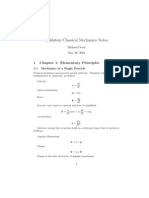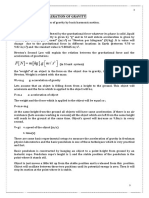Angular Momentum
Angular Momentum
Uploaded by
prakush_prakushCopyright:
Available Formats
Angular Momentum
Angular Momentum
Uploaded by
prakush_prakushOriginal Title
Copyright
Available Formats
Share this document
Did you find this document useful?
Is this content inappropriate?
Copyright:
Available Formats
Angular Momentum
Angular Momentum
Uploaded by
prakush_prakushCopyright:
Available Formats
Angular Momentum.
Physics 3550, Fall 2012 Angular Momentum. Relevant Sections in Text: 3.4, 3.5 Angular Momentum You have certainly encountered angular momentum in a previous class. The importance of angular momentum lies principally in the fact that it is conserved in appropriate circumstances, as we shall explore. It is worth noting that the angular momentum of electrons in atoms is one of the most important physical features of atoms and largely makes them what they are. The angular momentum of a single particle is dened by* l = r p, where usually the momentum is just p = mv (more on this later). Notice that the angular momentum involves the position vector, which is dened relative to a choice of origin. Thus the angular momentum is dened relative to an origin. It is easy to forget this. Dont. As I mentioned, we focus on angular momentum because of its conservation under appropriate circumstances. What are these circumstances? Well, let the particle move according to Newtons second law, we have dl = v (mv ) + r F . dt The rst term involves the cross product of two parallel vectors and so it vanishes. We then get dl = , dt where =rF is the torque. Like the position vector and the angular momentum, the torque is always dened relative to a choice of origin. We tacitly assume the torque is dened relative to the same origin as the angular momentum. We see then that the angular momentum of a particle is conserved if and only if the torque vanishes. For a single particle, the torque can vanish and angular momentum is conserved in three possible ways, which you can easily see from the denition of torque as a cross * Why is angular momentum dened this way? Is it always dened that way? Why is the total angular momentum conserved? All these questions will be answered when we explore the Lagrangian form of mechanics. 1
Angular Momentum.
product. Either (i) the particle spends all its time at the origin. Or (ii) the net force on the particle is zero. Or (iii) the force is (anti)parallel to the position vector, i.e., the force points toward or away from the origin. The latter possibility is the most important; such forces are called central forces. What happens if you we use dierent origins to compute our angular momenta? Let the two origins dier by a vector d, the two position vectors are related by r1 = r2 + d, while the velocities and momenta are the same relative to the two choices of origin. So the two angular momenta are related by l1 = l2 + d p. Note, in particular, that this means if the angular momentum relative to a particular choice of origin is conserved it may not be conserved relative to another choice of origin: dl1 dl dp dl = 2 +d = 2 + d F. dt dt dt dt A classic and important application of angular momentum conservation appears in trying to understand Keplers second law of planetary motion. Recall that Keplers rst law says that planets move on ellipses, with the sun at one of the foci. (We will prove this later.) The second law of Kepler says that the motion in time of the planets is such that the relative position vector of the planet and the sun sweeps out equal areas in equal times. This result can be understood via conservation of angular momentum. Lets look into this. First, we assume for simplicity that the sun is so much more massive than the planets that the center of mass can be idealized as being at the center of the sun:* R= 1 msun rsun + mplanet rplanet rsun , msun + mplanet mplanet << msun .
It is this point which the planets orbit around and it is there we place the origin. To verify that the angular momentum (about this origin) is conserved we note that in the chosen reference frame the force on the planet is of the form k F = 3 rplanet , rplanet where k has Newtons constant and the masses. This is a central force; the torque vanishes and angular momentum is conserved. * This assumption is not needed, as we shall see. 2
Angular Momentum.
Now we prove Keplers second law using angular momentum conservation. Consider the position vector at two nearby times, t and t + dt. In the limit as the time interval vanishes, the two position vectors and their relative displacement form a (very skinny!) triangle with edges r(t), r(t + dt), and dr = r(t + dt) r(t). Next we use an important math fact: a, b and c = a b dene a triangle whose area is the magnitude of one-half the cross product of any two of the vectors. You can easily check this and you should check it since this is one of the main geometric intepretations of the cross product. Applying this result to the position vectors we have that the area dA swept out in time dt is 1 dA = ||r dr||. 2 Now, divide by dt to get* dA 1 1 = ||r p|| = l. dt 2mplanet 2mplanet So, assuming l (or at least its magnitude) does not change in time, we see that the rate of change of area is constant in time, i.e., A(t2 ) A(t1 ) = (const.)(t2 t1 ), or A = (const.)t, which is Keplers second law. (We got this formula by integrating.) Let us look at another example. We return to the system consisting of a charged particle (mass m, charge q ) moving in a uniform magnetic eld, Bk . The force is F = qv B. The magnetic eld is homogeneous (but not isotropic); we can x the origin anywhere we like. The torque is = r F = qr (v B ). Next I invoke a very famous vector identity (you should make sure you know this one): A (B C ) = (A C )B (A B )C. * Note this is a nice, generally valid, geometric interpretation of the magnitude of angular momentum. 3
Angular Momentum.
From this identity the torque takes the form: = q (r B )v (r v )B. From this result we can recover the familiar result that for circular motion in a plane perpendicular to B , the angular momentum is conserved. The angular momentum in this case is parallel to B and has magnitude mvr, where v is the particles speed and r is the radius of the circle. Make sure you can prove this to yourself. Angular momentum of a system of particles Let us now consider a system consisting of two particles; the generalization to more than two particles is pretty straightforward. We dene the total angular momentum as L = r1 p1 + r2 p2 . The time rate of change of this observable is dL = r1 F1 + r2 F2 = 1 + 2 = . dt We have denoted by the total torque on the system. The force on, say, particle 1 is a superposition of the force F21 from particle 2 and any external forces F1ext : F1 = F21 + F1ext . Similarly, for the force on particle 2 we have F2 = F12 + F2ext . Let us assume that the interparticle force obeys Newtons second law. We have F21 = F12 F . We can then write dL = (r1 r2 ) F + ext . dt We now generalize our notion of central force. We say two particles interact via a central force if the mutual force is always directed along a line joining the two particles. In this case, we have dL = ext . dt If there are no external torques the angular momentum is conserved. 4
Angular Momentum.
A good example of a central force is the gravitational force, where F21 = G m1 m2 (r2 r1 ). |r1 r2 |3
So, for a binary star system, ignoring all external inuences, the total angular momentum is conserved. As a nice exercise you can show that if, say, m2 >> m1 , (as in the system of a planet and the sun) the usual 1-particle central force law discussed earlier in the context of Keplers laws is recovered. You can easily generalize this discussion to three or more particles. The key result is that, for a system of particles interacting via central forces, the time rate of change of total angular momentum is given by the net external torque.
Motion in a plane Let us consider a nice application of some of our ideas developed thus far. Consider the motion of two particles under a mutual central force with no other forces (e.g., gravitational forces only). Again, think of a binary star system, or the Earth-Sun system, Earth-Moon system, etc. We can now show that there always exists a reference frame in which the motion must lie in a plane. The proof is pretty simple. First of all, since the forces are internal and obey Newtont third law the center of mass of the system must have no acceleration. Let us work in the reference frame which is at rest relative to the center of mass. Put the origin at the center of mass. In this reference frame we have m1 r1 + m2 r2 = 0, m1 v1 + m2 v2 = 0. The rst equation just says the center of mass is at the origin. The second equation is just the time derivative of this equation telling us the center of mass is at rest in this reference frame. Note that this reference frame has the particles always having diametrically opposed position vectors. Now, consider the conserved total angular momentum; we have L = r1 p1 + r2 p2 = r v, where r = r1 r2 , are the relative position and velocity and = m1 m2 m1 + m2 5 v = v1 v2 ,
Angular Momentum.
is the reduced mass. To prove this, you need to use r1 = m2 r, m1 + m2 r2 = m1 r. m1 + m2
The point of this result is the following. The total angular momentum L is conserved. This means that, as time runs, positions and velocities change, but r v is a xed vector in space. In particular, its direction is xed. Since r and v are perpendicuar to this xed vector, as time evolves the relative position (and velocity) moves in a plane orthogonal to L. But this means that each of the particles moves in that plane. This is why planetary motion is always in a plane the plane being determined by the angular momentum of the system. Now for an amusing little paradox. Consider two bodies moving under an attractive central force, such as just described. The system could be the Earth-Sun system, or it could be the hydrogen atom. Under what circumstances is the angular momentum zero? Well, evidently, we can get L = 0 by either having (i) r = 0, or (ii) v = 0, or (iii) r || v . Physically these mathematical relations say: (i) the particles are on top of each other, (ii) the particles are moving with the same speed in the same direction, (iii) the particles are moving toward each other or away from each other. The rst situation is a collision. The second situation only happens when there is no force. The third situation corresponds to a collision in the future, or one in the past. Now for the paradox: the ground state of the hydrogen atom has zero angular momentum. How can this be?
You might also like
- Running Kinematics LabDocument3 pagesRunning Kinematics Labapi-236276342No ratings yet
- Goldstein Classical Mechanics Notes (Michael Good 2004)Document149 pagesGoldstein Classical Mechanics Notes (Michael Good 2004)Karan Gupta100% (1)
- MIT8 01SC Problems28 Gaya SentralDocument9 pagesMIT8 01SC Problems28 Gaya SentralAbdul HamidNo ratings yet
- Ph2100 Final Exam Fall 2016Document13 pagesPh2100 Final Exam Fall 2016Anonymous L21MIUqANo ratings yet
- Angular Momentum 1Document29 pagesAngular Momentum 1Atif ImamNo ratings yet
- CM Rigid Body DynamicsDocument16 pagesCM Rigid Body DynamicsGregorius FilipusNo ratings yet
- Concepts in Theoretical Physics: Lecture 1: The Principle of Least ActionDocument19 pagesConcepts in Theoretical Physics: Lecture 1: The Principle of Least Actionsupremely334No ratings yet
- Lecture Notes For Physical Chemistry II Quantum Theory and SpectroscoptyDocument41 pagesLecture Notes For Physical Chemistry II Quantum Theory and Spectroscopty3334333No ratings yet
- Goldstein Classical Mechanics Notes: 1 Chapter 1: Elementary PrinciplesDocument149 pagesGoldstein Classical Mechanics Notes: 1 Chapter 1: Elementary PrinciplesPavan KumarNo ratings yet
- 1 Classical MechanicsDocument11 pages1 Classical MechanicsJayant MukherjeeNo ratings yet
- 0054 Handout 6Document14 pages0054 Handout 6zcaptNo ratings yet
- Basic Physics: Some Concepts For Geodesy: James R. Clynch, 2003Document10 pagesBasic Physics: Some Concepts For Geodesy: James R. Clynch, 2003Rendi Adi FebrianNo ratings yet
- Notes On Mechanical Vibrations: 1 Masses and Springs-The Linear OscillatorDocument10 pagesNotes On Mechanical Vibrations: 1 Masses and Springs-The Linear Oscillatoramlandas08No ratings yet
- الملزمة الرئيسية الفيزياء Document54 pagesالملزمة الرئيسية الفيزياء m4332060No ratings yet
- FN MKGGMS: Experiment 2.acceleration of GravityDocument8 pagesFN MKGGMS: Experiment 2.acceleration of GravityJessica RossNo ratings yet
- 6.7 Introduction Dynamics in Three Dimensions A. General PrinciplesDocument12 pages6.7 Introduction Dynamics in Three Dimensions A. General PrincipleselvyNo ratings yet
- Chapter4 MechanicsDocument19 pagesChapter4 MechanicsHusain AliNo ratings yet
- Lectures On General RelativityDocument63 pagesLectures On General RelativityMichael Anthony MendozaNo ratings yet
- N - Body Problem: L1 A3-401 - Newton's Law of GravitationDocument22 pagesN - Body Problem: L1 A3-401 - Newton's Law of Gravitationudayang5330No ratings yet
- MIT8 962S20 Pset06Document5 pagesMIT8 962S20 Pset06Robin Red MsiskaNo ratings yet
- 1 - Mechanics Revision NotesDocument5 pages1 - Mechanics Revision NotesHuaxiang HuangNo ratings yet
- CM 15 Keplerian OrbitsDocument9 pagesCM 15 Keplerian Orbitsosama hasanNo ratings yet
- Questoes de Relatividade 1Document33 pagesQuestoes de Relatividade 1Sk1lzNo ratings yet
- Momentum: Nirmaan Shanker October 2015Document7 pagesMomentum: Nirmaan Shanker October 2015Nirmaan ShankerNo ratings yet
- PHYSICSDocument35 pagesPHYSICSPrincess Mae AlejandrinoNo ratings yet
- Lecture L15 - Central Force Motion: Kepler's LawsDocument12 pagesLecture L15 - Central Force Motion: Kepler's Lawsletter_ashish4444No ratings yet
- Limitations of An Euler Method N-Body Simulation and Shape of Sun-Earth OrbitsDocument18 pagesLimitations of An Euler Method N-Body Simulation and Shape of Sun-Earth OrbitsClarisse ThomasNo ratings yet
- Introduction Orb MechanicsDocument9 pagesIntroduction Orb MechanicsParag MahajaniNo ratings yet
- Phy 206 Rlec 4Document9 pagesPhy 206 Rlec 4ph23b001No ratings yet
- Formula FizikDocument10 pagesFormula Fiziknew_farhanNo ratings yet
- VectorsDocument82 pagesVectorsNaledi xuluNo ratings yet
- Oscillations: Institute of Lifelong Learning, University of DelhiDocument36 pagesOscillations: Institute of Lifelong Learning, University of DelhiVenkataramanan SureshNo ratings yet
- Relativity v1.2Document13 pagesRelativity v1.2hassaedi5263No ratings yet
- Week6 Homework4 PulsarsDocument5 pagesWeek6 Homework4 PulsarsastodudeNo ratings yet
- MCE312 (Module 1)Document32 pagesMCE312 (Module 1)Muiruri JacobNo ratings yet
- Rotational Motion and System of Particles (ISC/NCERT)Document16 pagesRotational Motion and System of Particles (ISC/NCERT)prakhar.dixit.399No ratings yet
- Physics12 09Document14 pagesPhysics12 09Ninja Warrior GamerNo ratings yet
- Experiment 12: Simple Harmonic Motion: I. About The ExperimentDocument6 pagesExperiment 12: Simple Harmonic Motion: I. About The ExperimentAnurag SharmaNo ratings yet
- Report On Nonlinear DynamicsDocument24 pagesReport On Nonlinear DynamicsViraj NadkarniNo ratings yet
- MIT16 07F09 Lec12 PDFDocument11 pagesMIT16 07F09 Lec12 PDFletter_ashish4444No ratings yet
- Moment of InertiaDocument6 pagesMoment of Inertiarohan_nerlekar794100% (3)
- 5 Central Force Motion: R R R RDocument17 pages5 Central Force Motion: R R R ROmegaUserNo ratings yet
- Eddy Diffusion: December 7, 2000Document30 pagesEddy Diffusion: December 7, 2000TariqNo ratings yet
- Ast1100 Fullstendig PDFDocument310 pagesAst1100 Fullstendig PDFmillian0987No ratings yet
- From Compton To LarmorDocument10 pagesFrom Compton To LarmorpaolotrNo ratings yet
- 1 Elementary PrinciplesDocument52 pages1 Elementary PrinciplesMirza Shahzaib ShahidNo ratings yet
- RelangmomDocument19 pagesRelangmomLeomar Acosta BallesterosNo ratings yet
- Legrangian FormalismDocument12 pagesLegrangian FormalismSreelakshmi AnilNo ratings yet
- Chapter 5 ConceptsDocument7 pagesChapter 5 Conceptssanvi.sharma.01No ratings yet
- SHM NotesDocument4 pagesSHM Notesgiulio.zizzo2850No ratings yet
- Lecture 7 (Handouts) - Physics Optional Foundation CSE 2021 by Quantum IASDocument25 pagesLecture 7 (Handouts) - Physics Optional Foundation CSE 2021 by Quantum IASAyush SharmaNo ratings yet
- Physics Formulas and ConceptsDocument23 pagesPhysics Formulas and Conceptschand7790No ratings yet
- Where Are We Now?: F L Q LDocument20 pagesWhere Are We Now?: F L Q LgornetjNo ratings yet
- Mechanics 3 Revision NotesDocument45 pagesMechanics 3 Revision NotesDexter FungNo ratings yet
- Linear Momentum: in Classical Mechanics, Momentum Is:: DependDocument9 pagesLinear Momentum: in Classical Mechanics, Momentum Is:: DependTarek MahmudNo ratings yet
- Physics of Rocket Flight: Distance, Velocity & AccelerationDocument10 pagesPhysics of Rocket Flight: Distance, Velocity & Accelerationvx800bikeNo ratings yet
- Formula FizikDocument9 pagesFormula Fizikqaslun basheer100% (2)
- Full Free Motion of Celestial Bodies Around a Central Mass - Why Do They Mostly Orbit in the Equatorial Plane?From EverandFull Free Motion of Celestial Bodies Around a Central Mass - Why Do They Mostly Orbit in the Equatorial Plane?No ratings yet
- Understanding Vector Calculus: Practical Development and Solved ProblemsFrom EverandUnderstanding Vector Calculus: Practical Development and Solved ProblemsNo ratings yet
- New Ideas for a New Era: Introduction to New Insights in Physics and Mathematics for a More Complete and Deeper Understanding of RealityFrom EverandNew Ideas for a New Era: Introduction to New Insights in Physics and Mathematics for a More Complete and Deeper Understanding of RealityNo ratings yet
- Dynamic Quenching of The Dual Fluorescence of Molecules: Condensed-Matter SpectrosDocument7 pagesDynamic Quenching of The Dual Fluorescence of Molecules: Condensed-Matter Spectrosprakush_prakushNo ratings yet
- Fluorescencequenching of Rhodamine6Gin Methanol A T High ConcentrationDocument7 pagesFluorescencequenching of Rhodamine6Gin Methanol A T High Concentrationprakush_prakushNo ratings yet
- JabDocument2 pagesJabprakush_prakushNo ratings yet
- Abb Silver NP PaperDocument11 pagesAbb Silver NP Paperprakush_prakushNo ratings yet
- 11JNN-4142 NiDocument6 pages11JNN-4142 Niprakush_prakushNo ratings yet
- Physical Science Module Q2Document25 pagesPhysical Science Module Q2GUTIERREZ, ANGELICA, TOLENTINONo ratings yet
- Hkcee Physics - Section 2 Mechanics - P.1Document33 pagesHkcee Physics - Section 2 Mechanics - P.1Y AdaNo ratings yet
- POD RULANT-exemple Mers Oblic (De La 2 Pana La Mai Multe Roti)Document145 pagesPOD RULANT-exemple Mers Oblic (De La 2 Pana La Mai Multe Roti)bebi66No ratings yet
- PC235W13 Assignment3 SolutionsDocument10 pagesPC235W13 Assignment3 Solutionskwok0% (1)
- A Review and Evaluation of Available Gait Analysis Technologies, and Their Potential For The Measurement of Impact TransmissionDocument15 pagesA Review and Evaluation of Available Gait Analysis Technologies, and Their Potential For The Measurement of Impact TransmissionMarianoNo ratings yet
- The Speed of Gravity-What The Experiments SayDocument17 pagesThe Speed of Gravity-What The Experiments SayJeff Pratt100% (1)
- Velocity Profile Generation For Trajectories of A Self-Driving CARDocument18 pagesVelocity Profile Generation For Trajectories of A Self-Driving CARTJPRC PublicationsNo ratings yet
- Physics1 PDFDocument7 pagesPhysics1 PDFAnthony Renz SilosNo ratings yet
- Foundation Mock Test Studying VIII 16 10 21Document18 pagesFoundation Mock Test Studying VIII 16 10 21Anil KumarNo ratings yet
- Aqa Phya4 1 W QP Jun11Document12 pagesAqa Phya4 1 W QP Jun11tonyaypNo ratings yet
- Free Fall DemoDocument38 pagesFree Fall DemoLogan LeeNo ratings yet
- BLV R: Series TypeDocument474 pagesBLV R: Series TypeGiovaniAricettiNo ratings yet
- Engineering Mechanics Lecture 1Document15 pagesEngineering Mechanics Lecture 1Khalid YousafNo ratings yet
- Rotational DynamicsDocument17 pagesRotational Dynamicssanits591No ratings yet
- Applied Mechanics - J Perrry (Cassell 1905) PDFDocument700 pagesApplied Mechanics - J Perrry (Cassell 1905) PDFAnonymous zXVPi2PlyNo ratings yet
- Nso Science Olympiad Sample Question Paper 1 Class 9Document31 pagesNso Science Olympiad Sample Question Paper 1 Class 9Shruti SomaniNo ratings yet
- Fiitjee Aits Jee Main 2019 PT IDocument23 pagesFiitjee Aits Jee Main 2019 PT IPriyasu GuinNo ratings yet
- SND K ChrsDocument6 pagesSND K ChrsJustine Laurence VicenteNo ratings yet
- BiomechanicsDocument24 pagesBiomechanicsdejvidveb1988No ratings yet
- Paper - 1: All India Open Test (Aiot) Jee AdvancedDocument24 pagesPaper - 1: All India Open Test (Aiot) Jee AdvancedNinad Akolekar100% (5)
- Physics Jamb Syllabus PDFDocument14 pagesPhysics Jamb Syllabus PDFLearning Space TutorsNo ratings yet
- HSC STD 12 Question Papers & SolutionsDocument253 pagesHSC STD 12 Question Papers & SolutionsDilshad KhanNo ratings yet
- UntitledDocument32 pagesUntitledmuhammad sallehuddin ismailNo ratings yet
- Gravity, Air Resistance, Terminal Velocity, and Projectile MotionDocument23 pagesGravity, Air Resistance, Terminal Velocity, and Projectile MotionlidahtakbertulangNo ratings yet
- Physics f4 Chapt 1 KSSM 2020 NotesDocument12 pagesPhysics f4 Chapt 1 KSSM 2020 NotesCheah Soon TikeNo ratings yet
- Goldstein 22 15 21 23Document9 pagesGoldstein 22 15 21 23Laura SáezNo ratings yet
- Gravitational Energy and Its Field: Harshit Binju, Debasish Talukdar, Sahil Mittal AbhishekDocument2 pagesGravitational Energy and Its Field: Harshit Binju, Debasish Talukdar, Sahil Mittal AbhishekInternational Journal of computational Engineering research (IJCER)No ratings yet
- BMCG 1253 Dynamics & Mechanism:: Newton's Second LawDocument19 pagesBMCG 1253 Dynamics & Mechanism:: Newton's Second LawAminullah MinNo ratings yet






























































































